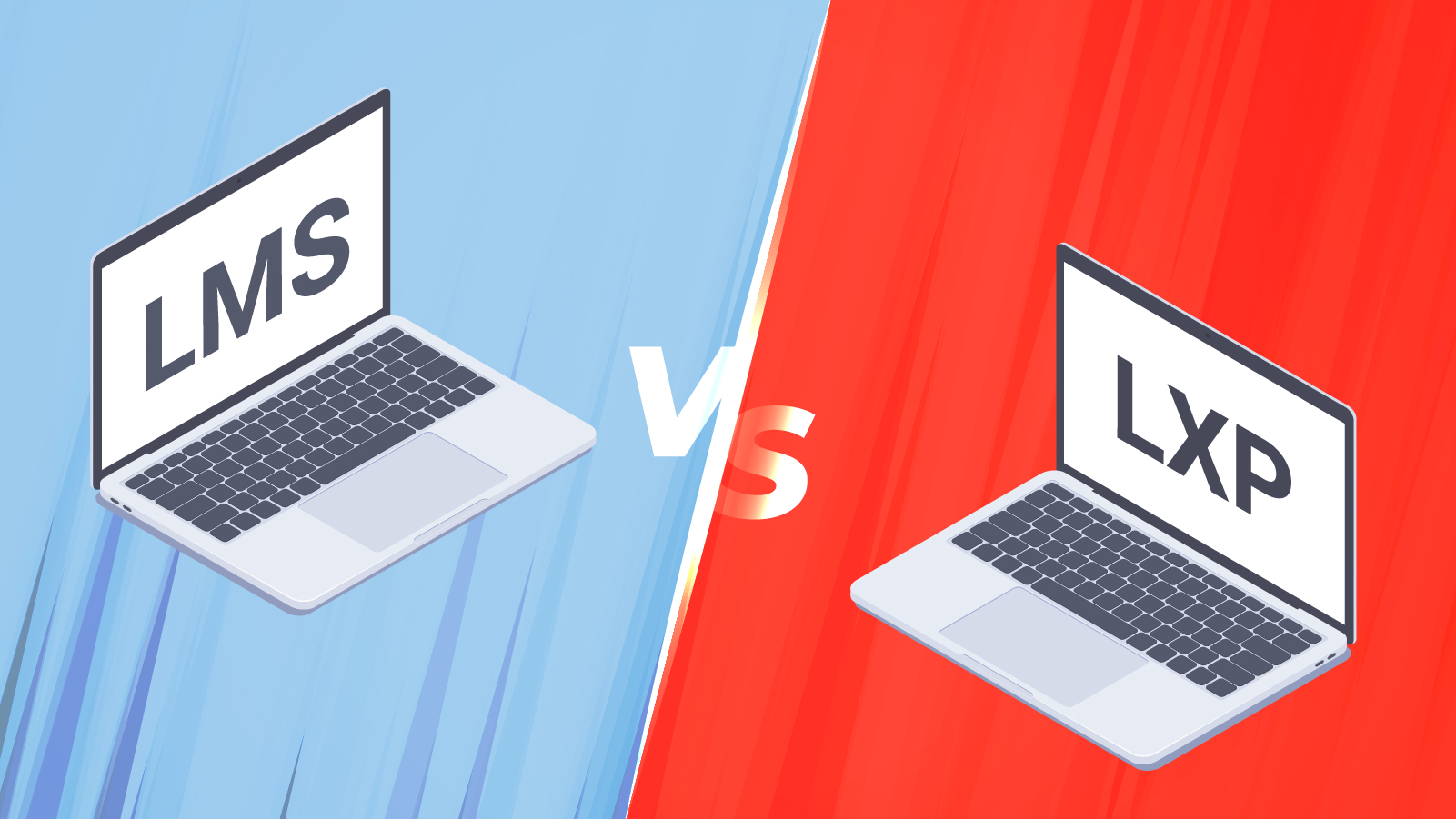
LMS vs LXP - What's the Difference?
If you are weighing up the pros and cons of an LMS vs LXP or even an integrated solution in a Learning Suite, here we offer an introduction to these concepts.
So what’s the difference between a learning management system (LMS) and a Learning Experience Platform (LXP)? It’s all about push vs pull.

What is an LMS?
An LMS is a tool for Learning and Development (L&D) managers, and often HR teams, to roll out training and make it available via desktop or mobile devices. It can enable anytime, anywhere learning if learners can access e-learning content online.
The LMS is most commonly used for employee onboarding and compliance training, getting new hires up to speed with health and safety, company procedures, product knowledge, and ongoing training that will support the organisation towards its goals.
Because this is very much top-down, it’s the Push side of training and is often mandatory as dictated by the company and managers, and perhaps also by law or industry regulators.
The benefits of an LMS include:
- The ability of L&D and HR to roll out training content quickly at scale - even to a global workforce
- A low cost way to update existing training materials when products, services or legislation change
- The ability to demonstrate completion of mandatory training, assisting regulatory compliance
- Learner analytics, which will help to identify individuals or groups need additional support.

What is an LXP?
The LXP is a relatively new concept that puts the focus on the learner and their wants in terms of education and training. It enables the exploration of optional learning content away from anything related to mandatory training.
The LXP takes into account the fact that different people have different personal and professional goals, with some people actively seeking out new learning opportunities beyond those specified as being essential by the employer.
AI and recommendation engines might be used to suggest e-learning content that might be of interest to each individual based on their current role and potential career path and / or their previous learning behaviour. This is similar to how Netflix will suggest TV shows or movies to watch next based on previous viewing behaviours.
Suggested content could be within the LXP itself or hosted externally, such as YouTube videos.
As the employee is in control of the pace and content of their learning, it is bottom-up and is the Pull side of training - suggested and encouraged, but never mandated.
The benefits of an LXP include:
- Making the employee feel valued and supported as an individual, creating a positive learner experience
- Creating a way for highly motivated employees to better their knowledge and skills, which in turn can benefit the company because talent can flourish
- Increased employee retention - the LinkedIn Workforce Learning Report of 2022 showed that with better internal mobility support, companies see an average tenure of 5.4 years - nearly double the 2.9 years found at companies that struggle with it
- Support for the broader digital learning transformation journey - as learner-initiated training will be more enjoyable, it helps the entire organisation become more engaged with e-learning as the primary way of enhancing knowledge and skills. This not only creates a culture of learning, but can add rocket fuel to the long-term digital transformation programme.

LMS, LXP or Learning Suite?
So with so many important attributes within both the LMS and LXP, do you need both? Many organisations do successfully manage two systems with some integration with HR and people management tools, but this can lead to some inefficiency and additional administration time.
The easier and more efficient way to leverage the benefits of an LMS and LXP is to have a single, integrated solution in a Learning Suite.
This modern solution allows L&D and HR teams to collaborate without duplication of effort and administration time, and allows the learner to seamlessly progress from mandatory training to optional learning for personal and professional development.
If you’re looking to create a culture of learning within your organisation to increase employee satisfaction and improve performance, as well as potentially accelerating digital transformation, a Learning Suite is certainly the way to go.
The imc Learning Suite is a modern platform based on decades of experience supporting training at some of the world’s best known brands. It’s highly customisable and brandable, and supports every type of training, from Compliance to AI-supported, Personalised Learning paths.
Because it easily integrates with existing people management and business software, it can slot in with existing technologies - minimising additional admin time to start leveraging its benefits.


The Dawn of Integrated Platforms
Setting up an entire learning ecosystem through the structure, connection via API & Artificial Intelligence are some considerations when integrating an LMS & LXP.

Headless LMS - definitely not brainless
A headless LMS makes data maintenance significantly easier while also facilitating greater flexibility and customisation, especially within a learning ecosystem comprising several systems in communication with each other.

A Digital Transformation Mindset for Your Learning Ecosystem
Here we look at the reality of what a digital transformation mindset is within an organisation and how your learning ecosystem is not just an aspect of it, but how it should be the central hub for change.
First of all, we need to clear up a myth. Digital Transformation is NOT about adding technology. It’s about cultural change across an organisation and a fundamental shift in how business is done.
Much like a hammer does not build a house - it’s simply a tool - technology does not make a digital transformation. If you want to take your organisation through a digital transformation programme, you need to shift how your managers and employees think and talk about work.
A digital-led organisation is one looking to find new levels of efficiency, profitability and future-proofing by being open to and adopting technologies that can make these happen. It’s a programme that is initially top-down but that requires buy-in at all levels and that has the goal of empowering employees and customers, so that the implementation is bottom-up.
Prominent IT industry expert Brian Solis defines digital transformation as:
“The realignment of or investment in new technology, business models, and processes to drive value for customers and employees and more effectively compete in an ever-changing digital economy.”
Because digital transformation is a mindset not confined to tech, it is relevant to any sector - even those seen as traditional and steady, such as Law and Accountancy. In fact, it is those sectors that are traditionally slow-moving and that are seen to play it safe where there is often most to gain. Digital transformation can be a powerful competitive advantage where you can leap ahead.

The components of digital transformation
For a large organisation looking at cultural change, where to start can be an overwhelming prospect. It’s important to achieve consensus among your leadership team. Like most IT projects that fail, the issue is rarely down to the technology but rather the communication and implementation process - the resistance that comes from new systems being forced upon a team that was not fully bought-in.
Back in 2018, Forbes estimated that $1.3 Trillion was spent on digital transformation initiatives, with 70% ($900 Billion) of that budget wasted.
Since then, business leaders have become increasingly aware that not what you implement but how you implement it is key to success.
Global technology giant Hitachi break digital transformation down into 6 key components:
- Innovation
- Collaboration
- Experience
- Infrastructure Modernisation
- Operational Excellence
- Information and Insights
By keeping these 6 areas front of mind, you can help to ensure that your ideas for digital transformation amount to much more than buying the latest hardware and software - they’re about broader business goals.
The successful Olympic British Rowing team of the early 2000’s had the mantra:
“Will it make the boat go faster?”
When looking at digital projects, every stakeholder should be asking similar questions: “Will this improve collaboration?”, “Will this increase operational excellence?” etc. But you should also ask questions at the implementation stage, such as “Are we ensuring collaboration, operational excellence etc” before, during and after the roll out of new digital systems.
The Role of your Learning Ecosystem in Digital Transformation
When you think of Learning within the context of Digital Transformation, you might think put the face to face training online right? Use elearning instead of traditional training…
Well, going from face to face to elearning is part of a digital transformation yes, and many organisations were forced to accelerate this process in the midst of the Covid-19 pandemic during 2020 and 2021 in particular.
However, the most powerful contribution that elearning can make within Digital Transformation is in creating the central hub where every area of an organisation can learn about the programme, how it affects their team and their role, and access the latest information about progress.

What is the Learning Ecosystem?
The word ecosystem comes from biology and refers to a specific geography and the complex interactions of all the living things (from large animals to plants and microscopic organisms) between each other and their environment.
Therefore, a learning ecosystem refers to the components of People, Technology, Tools (including Data), Systems and Culture that affect Learning. Some definitions include Strategy as one of the components. However, if you are going to proactively create a learning ecosystem then the Strategy should sit above it and contain your guiding principles. It should define how you are going to create and shape the learning ecosystem.
A learning ecosystem will involve the L&D team of course, the Learning Suite (an LMS, LXP or even better - an integrated solution), and the way data on elearning is collected, processed and shared. Crucially, a learning ecosystem will every learner (ie every person) across the organisation and the collective attitude towards learning.
A digital learning ecosystem, if created and managed well, can embody the entire digital transformation. It involves using a digital-first approach to every aspect of learning and knowledge sharing.
At the centre of this digital learning ecosystem is the learning platform or ‘learning suite’ - the main L&D toolkit for managing and rolling out learning to every member of the organisation.
A modern, branded, engaging Learning Suite will perform two major functions:
Push training out
Push training out to relevant parties as and when required at the time and speed of need. This is a common learning management system (LMS) functionality. It allows HR, L&D and other business leaders sight of training progress so that they can ensure their teams are up to speed with new systems and organisational processes.

Pull employees in
Pull employees into the digital transformation programme by being home to all the current thinking, planning and progress information. Done well, there will be background documents, company vision videos from leaders, cross-departmental data and more.
By making such information available 24/7, every employee can feel that they are on the digital transformation journey with the company, and that there is greater transparency than being told about a programme by email or a one-off memo.
Benefits of a Digital Learning Ecosystem
A great learning ecosystem will be much more than where you go to complete training when you are told to. It will be where employees and managers can go to learn about what their peers are doing in other departments and share ideas, fostering greater team spirit.
Ideas can be shared and found, leading to experience being harnessed and retained, even when talent inevitably leaves from time to time.
Such knowledge sharing can be a powerful tool in ensuring operational excellence, being a meeting place for collaboration and uncovering useful information and insights.
Rather than digital projects happening in silos, signposting them within your learning ecosystem will provide data and insights that enable other teams to learn about what has worked (or not) within the organisation, where integrations may be possible, and where people can communicate and help each other.
In Summary
Peter Drucker suggested that the greatest contribution of management in the 20th Century was the 50-fold increase in productivity among manual workers through managerial practices.
The term ‘digital transformation’ took hold around 2013-14 and although many companies have experienced hiccups and stumbles, it could well have similar impact in the 21st Century. In the knowledge economy, companies who do digital transformation well could bring massive increases in productivity among their knowledge workers.
By placing a well thought-through Learning Ecosystem at its heart, your Digital Transformation could be designed, developed, implemented and leveraged to make your organisation a 21st century leader.

Learning culture nourishes learning ecosystem
“No appointments today – I’m learning.” Is it possible to write that without earning funny looks? Making it possible is a key task for modern companies. Learning and professional development must lose the “necessary evil” or “seminar as a benefit” labels and be anchored as a vital component of corporate culture.

Learning ecosystem: A universe of Learning
To successfully establish a Learning Ecosystem wthin a company-wide LMS, the technical requirements must be right. We reveal which stumbling blocks you better avoid and how employees can be optimally integrated.
Contact person

Fosway Group: "Focus On Your Learning Ecosystem"

Fiona Leteney
Fiona Leteney is the Senior Analyst for Learning Systems at Fosway Group, Europe’s #1 HR industry analyst. She has worked in the learning technology market since 2000, gaining a wealth of experience by either selling, implementing or managing learning solutions in a corporate context.
Terms such as LMS, NGLE and LXP are confusing for corporate buyers. The definitions aren’t clear and it’s hard to differentiate between the different types of technologies. That’s why in the February 2020 Learning Systems 9-Grid™, Fosway took the bold decision to reclassify Learning Systems as Suites and Specialists with the aim of more clearly and accurately defining the market. Organisations have always had a learning ecosystem of platforms and tools but the acceleration to digital-first ways of working and hybrid working require the ecosystem to be optimised to deliver impact and value.
This blog will explain the reasons why:
- The new classification is more reflective of the current learning systems market
- The ecosystem concept of combining suites and specialists is the way forward
- The connectivity of the ecosystem and circulation of data is more important than ever before

LMS & LXP labels no longer reflect the current learning systems market
Market perception is that the LMS represents traditional ‘tick-box’ compliance and ‘click-next’ content. A new label (LXP) encouraged the market to look to a fresh new future. However, over recent years the lines between the two types of system have blurred and those vendors who thought that formal learning and LMS functionality could be ignored were mistaken. This is true, particularly in the mid-market, where buyers can neither afford nor justify the purchase of more than one learning system. As the market now both accepts and adjusts to the Fosway classification of Suites and Specialists, some vendors have re-evaluated their target positioning and where they fit in the corporate ecosystem. Some specialists have prioritised innovation over backfilling core learning management functionality, often preferring to partner with other Suites instead. Suites have added LXP capability, whatever they perceive that to be.
The ecosystem concept of combining suites and specialists is the way forward
Learning technology has always been an ecosystem with many components, including the Learning Systems (LS), sources of HR data, virtual classrooms, authoring tools, learning content and other resources. Seamless integration has often been an issue, many corporates choosing not to tackle the problem, leaving them as separate, stand-alone technologies and making a single source of truth for data an unreachable goal. This is no longer a viable option even for learning at the mid-market level. However, even more integrations are required as an organisation gets larger, more complex and their core LS does not deliver the depth of functionality in specific areas. So, platforms with specialisms such as training resource management, curation, extended enterprise or programmatic learning might be added to the learning ecosystem.
However, the ecosystem is expanding beyond learning, connecting with the HR System(s) for the learner’s profile has always been a priority but now the lines are also blurring between communication, learning, performance and talent. It’s all about the data flow and the term we use to describe the ability to do this well is ‘Ecosystem-ness’. Vendors will rightly say that APIs solve this problem, but building integrations require integrators, i.e. developers and other experienced people to build and maintain them. In a complex company, that is expensive and non-trivial. In smaller companies it is impossible as they lack the resources and budgets to develop their own integrations. The more that Ecosystem-ness is of the out-of-the-box, the better off all buyers will be.

To deliver value & impact requires ecosystem connectivity and circulation of data
The ecosystem provides the opportunity to deliver a new level of learning impact. Take this scenario for example: an employee is recruited because of their existing skills which are noted, their learning through the onboarding process takes care of the gaps and time-to-value in the new role is measured. Successful performance is demonstrated and rewarded during the delivery of internal or external projects. Awareness of new opportunities for further development and upskilling are at the learner’s fingertips along with collaborative assignments or individual coaching. The manager has access to their team’s progress to ensure intervention is possible when necessary. The organisation can recognise the skills gaps across the whole organisation and initiate reskilling for competitive advantage and growth. Learning is at the centre of this and at every stage!
But none of this is possible in an effective efficient way without all the various HR, talent and learning system suites and specialists being integrated to ensure the data flows unimpeded. Which is why the ability for a vendor to demonstrate ecosystem-ness is crucial.
And if all this can take place behind the scenes, mostly hidden from view and the employee has access to everything wherever they are working on a day-to-day basis then we’ve cracked it!
Find out more about the Fosway 9-Grid™ for Learning Systems and read the full report here and you can contact Fiona via @fionaleteney or @fosway on Twitter and LinkedIn.
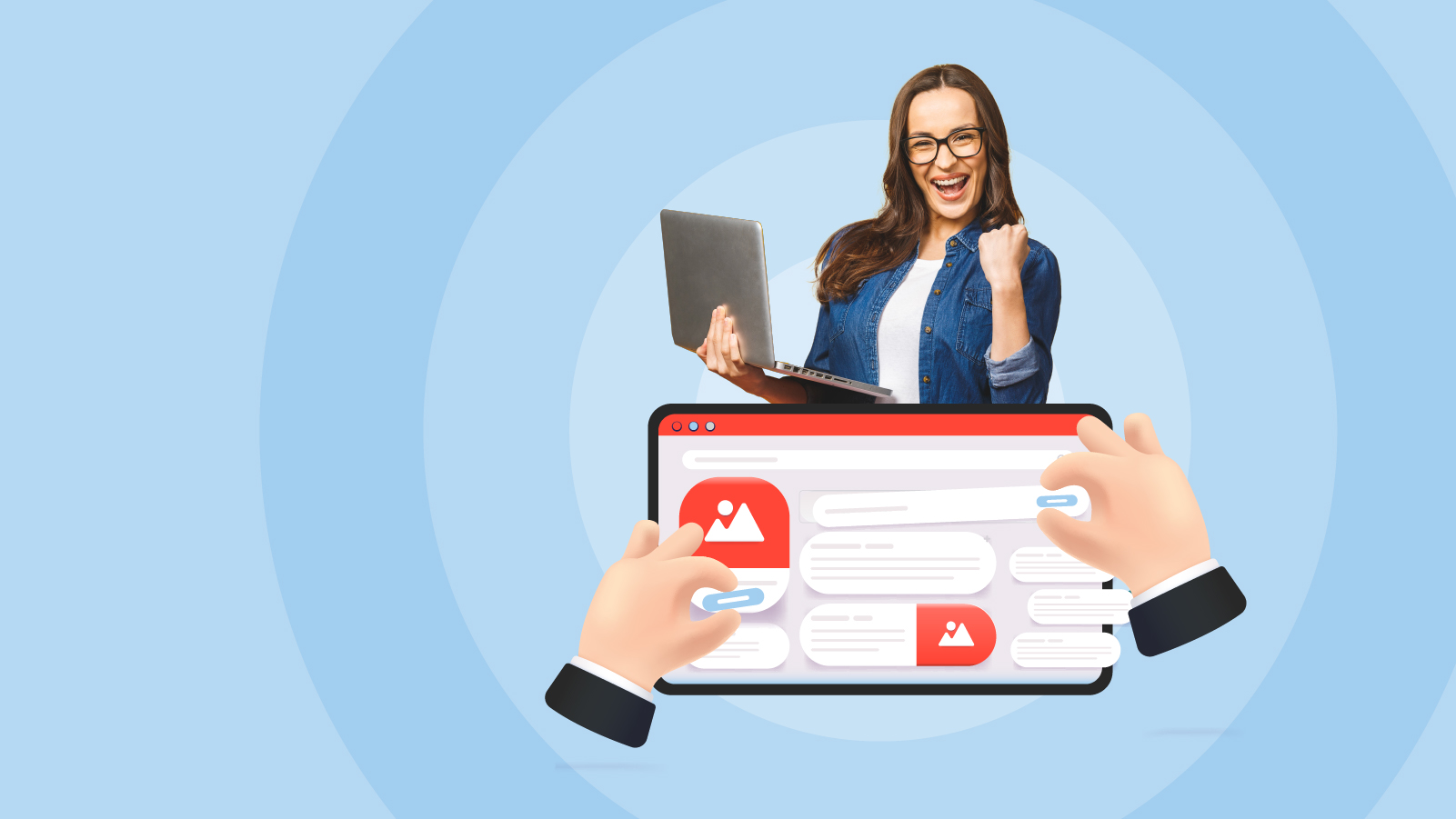
How to create the perfect learning experience
The best learning experience for your organisation is tailored and personalised to your needs and wishes. How do you create the perfect environment?

What do you need for the ideal learning ecosystem?
How do you combine cutting-edge technology, compelling content and an effective strategy to create the ideal learning ecosystem?

Commonwealth Games case study: imc Express e-learning content
Welcome to the third in our series exploring imc’s project with Birmingham 2022 Commonwealth Games. In this post, we will explore how the Commonwealth Games used the imc Express authoring tool to create their own eLearning content in-house.
The Birmingham 2022 Commonwealth Games organising committee needed a lot of custom content to support their workforce of over 50,000 employees, contractors and volunteers. Ideally, this would be created in-house, meaning they needed an efficient, easy-to-use authoring tool to produce lots of eLearning content in a short period of time.
Why did the Commonwealth Games choose imc Express?
imc Express is an easy-to-use authoring tool that takes the hassle out of content creation. Learning teams can easily import text from Microsoft Word, add multimedia content, drag-and-drop images and build interactive learning activities to build engaging learning experiences. To support the most inclusive Commonwealth Games ever, video content is automatically subtitled, ensuring it’s accessible to the entire workforce.
On top of this, imc Express offers a range of pre-made and customisable design templates, along with didactic templates to help authors convey their content in a didactically meaningful way. Content is adaptive and responsive for all devices, ensuring it’s suitable for the Commonwealth Games’ large, diverse audience who may be accessing training from desktop computers, tablets or smartphones.

Creating content with imc Express
The Birmingham 2022 Commonwealth Games team has two imc Express ‘super users’ with the overall responsibility for managing the eLearning content creation process. These super users will set up the templates and send them out to each functional area in line with demand for new learning content.
The templated approach will empower more people to create learning content without needing extensive development or design experience, while also being able to create engaging and interactive eLearning content instead of a plain PDF.
Content straight from the in-house experts
The Birmingham 2022 Commonwealth Games only has the budget for a select few highly interactive modules to sit on their LMS, and with no dedicated in-house content provider, imc Express will make it much easier to spread the content creation workload across functional areas of the organisation, ensuring modules come straight from the experts for the best-quality training.

Why Birmingham 2022 Commonwealth Games needs custom content
With 43 different functional areas (or departments), the Birmingham 2022 Commonwealth Games needs to accommodate a wide range of learning requirements.
There are 279 different volunteer roles within these functional areas, covering everything from transport to media to medal ceremonies; much of which will be unique to the Birmingham 2022 Commonwealth Games.

How the Commonwealth Games is using custom eLearning content
This custom eLearning content will supplement the in-person training which takes place within the Commonwealth Games venues in Birmingham, ensuring volunteers can make the most of their face-to-face time. The modules created in imc Express will help volunteers know what to expect before their in-person training, giving them a useful overview of their roles and the tasks they can expect to perform.
Over 50 courses were created, in-house, in no time. Many static documents and plain text resources were transformed into engaging, interactive eLearning. This was made significantly easier by the fact that with imc Express, a single plain text input can be converted into multiple outputs, such as SCORM, web content or ebooks. This content was then imported directly from imc Express into the Learning Magagement System (LMS), reducing manual content upload.
Providing this content as soon as volunteers have their roles, ensures that they can start to prepare for the games immediately without having to wait for their face-to-face training. They will have access to photos, videos, maps and more created with imc Express by leaders in their functional area, ensuring they can turn up for their face-to-face sessions with a foundation of knowledge.
This primarily self-created approach will also allow the Birmingham 2022 Commonwealth Games team to accommodate inevitable last-minute requests for learning content, as they can all be quickly created in-house using templates and the imc Express tool’s artificial intelligence to pull together accessible, attractive and engaging learning resources for thousands of volunteers, contractors and paid employees.
More about this project
Join us for part 4 when we will take a look at the implementation of imc’s LMS for the Birmingham 2022 Commonwealth Games, including the challenges they overcame and how they launched the LMS to a workforce of over 50,000…

A future-proof LMS for 2022 Commonwealth Games
A future-proof digital learning solution with multitenancy LMS to train large numbers of volunteers and contractors at the 2022 Commonwealth Games within a short time frame.
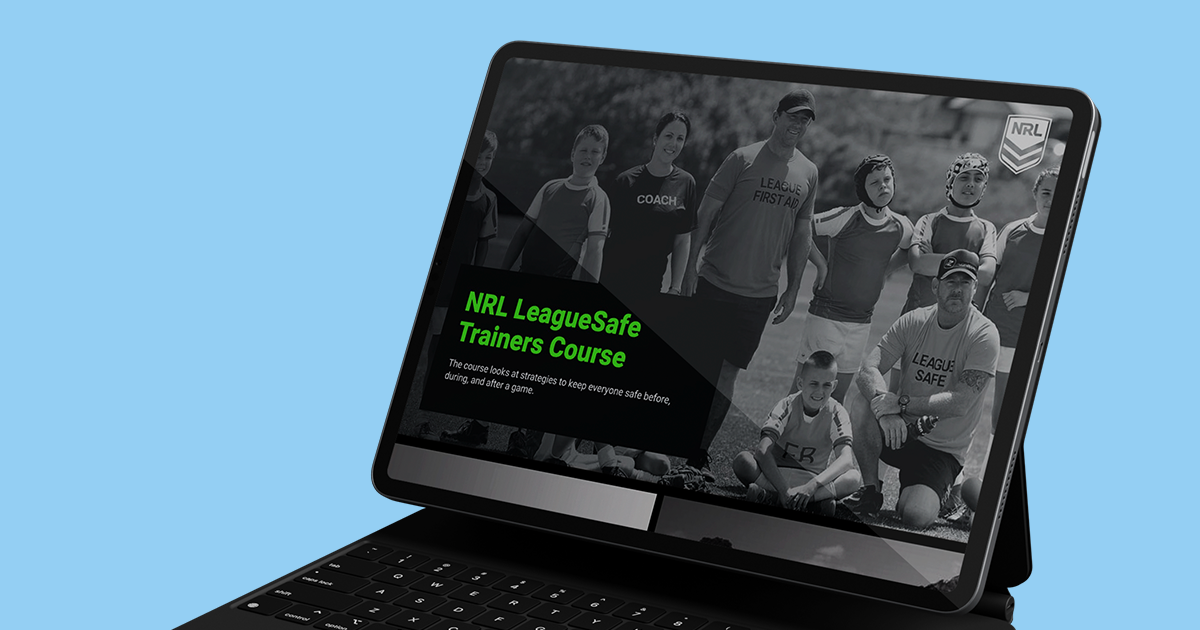
A holistic learning management experience for Australia’s national rugby league
A rejuvenated approach to modernise NRL learning centre portal with a fully-integrated LMS that increased participation rates and positive learner feedback.

Birmingham 2022 Commonwealth Games case study: The solution
Welcome to the second in our series of posts exploring imc’s project with Birmingham 2022 Commonwealth Games. In this post, we will look at imc’s solution, including how the design tied into the Commonwealth Games organising committee’s unique requirements.
Following Birmingham 2022 Commonwealth Games’ public procurement process, imc’s proposed solution clearly came out on top. This was, in part, thanks to imc’s experience with other sporting organisations, such as Australia’s National Rugby League, along with their on-budget and on-brief solution.
Birmingham 2022 Commonwealth Games project kickoff
The project kickoff took place in November 2021, with the initial go-live planned for late February 2022 - a very tight timeframe for such a large-scale, complex LMS project, so efficient working practices were a must.
An inclusive learning platform
A key consideration for this project was that the Birmingham 2022 games will be the most inclusive Commonwealth Games to date, with more medals for women and a bigger para-sport programme than ever before. Birmingham is also a very diverse city in the UK’s West Midlands. This need for inclusion had to be reflected in the choice of learning platform. The LMS needed to be simple, accessible and suitable for use by a wide range of learners.
Building an LMS within time limitations
Additionally, it was vital that this programme remained within the planned scope. With such limited time, it was not an option to stray outside the initial plans, so the Commonwealth Games organising committee and imc agreed very early on that this LMS needed a very clear focus with no room for scope creep.

Designing the programme
With so many volunteers and contractors involved in the Birmingham 2022 Commonwealth Games, it was essential that the programme ran efficiently and didn’t take up more time than was absolutely necessary. The last thing the Commonwealth Games organising committee wanted was to ask a volunteer working four shifts to participate in a full week of training, so a smart design was extremely important.
All employees, contractors and volunteers involved with the Birmingham 2022 Commonwealth Games must attend four-hour face-to-face orientation sessions to help them familiarise themselves with the venues and procedures specific to each location. Therefore, a blended learning programme was quickly established as the best approach, with the LMS providing additional bitesize training and support while protecting limited face-to-face time.
Integration with a workforce management system
The Learning Management System (LMS), B-Bright, takes user data from workforce management system Rosterfy, the volunteer portal. For the Birmingham 2022 Commonwealth Games, this takes place through a simple data transfer service, but with more time to prepare for future games, these systems will be integrated. This is one of the advantages of a multi-games contract – lessons learned from this version can be directly implemented in future versions, instead of starting from scratch each time.

Managing users
There are thousands of people involved in the Commonwealth Games, all of whom have different learning needs and roles to prepare for, across 43 functional areas and 279 different volunteer roles. The data transferred from Rosterfy to the LMS flags the type of user and automatically gives them access to the relevant training within the course catalogue.
This data also tells the LMS which functional area the learner works in, so they are also automatically enrolled into role-appropriate courses. This removes a huge amount of manual work for the organising committee, and ensures that the user management process is streamlined and efficient,
A future-proof solution
The LMS is built with multitenancy in mind. While this solution will be operational for the six months around the Birmingham 2022 Commonwealth Games, the platform itself will be reused for future games.
User data for future games will be completely separate from the Birmingham 2022 users, meaning that unique designs and content can be applied to the LMS without affecting other host cities’ experiences.

An agile approach
This solution has been designed with future games in mind right from the start of the process. While the Birmingham 2022 Commonwealth Games requires a quick, on-brief solution, there will be much more time to automate more elements of the platform for future games. Owing to this agile approach, the larger scope of more complex learner journeys and close integration with other systems can be iteratively rolled out over time. Getting started with what is required now with built-in flexibility means that the solution will be ready to adapt to what is needed in the future.
More about this project
Join us for part 3 when we will take a look at how the Birmingham 2022 Commonwealth Games organising committee used the imc Express authoring tool to create their own customised eLearning…

Part 1: An LMS for the 2022 Commonwealth Games
The challenges to designing a digital learning solution for a large & diverse audience at the 2022 Commonwealth Games in Birmingham.

A podium spot with eLearning
Training is not only essential for the professional athletes, but their trainers, referees and crew members also need continuous professional development. We tell you how that works with eLearning.

How to Implement Compliance Training Online
Here we look at how to implement compliance training online using a learning suite to automate repetitive tasks, track learner progress and ensure that refresher courses and recertifications are completed successfully.
By leveraging the latest learning technology, your organisation can stay compliant while saving valuable time and money, as well as engaging employees with the training process.
A modern ‘learning suite’ will comprise capabilities as both a learning management system (LMS) and a learning experience platform (LXP). When it comes to mandatory training to stay compliant with legal or industry regulations, the former is most relevant.
So below we look at 5 key capabilities you need in a good LMS for compliance training. We then offer 5 quick tips for making compliance training engaging, as well as effective.

Automate Compliance Training
The imc Learning Suite enables you to define target groups for training courses and book them automatically. Progress is continuously documented from the time of booking, and learners can be reminded by automatic messages to complete these courses within the required period.
An automated refresher training mechanism ensures that the course is repeated regularly, so that the employee always meets all compliance requirements. All status changes are stored throughout the entire process, ensuring that all compliance-relevant activities can be tracked and monitored across the board.
By using personal profile data, new employees can also be automatically trained according to requirements during the onboarding process. The imc Learning Suite also supports maintenance through necessary repeat training and recertification.
All compliance-relevant activities are supported by the system, from the nomination of target groups to the tracking of course progress and the so-called “chasing“, right through to the reporting of training measures.
Keep the above info block but remove ‘the’ to read just ‘Reduce susceptibility to errors’.

Assign Training
The training assignment process describes the formation of target groups for defined compliance requirements and the selection of training measures that must be carried out to meet the requirements.
The imc Learning Suite provides support by defining and selecting target groups via inclusion and exclusion rules. Assignment criteria can for example be courses, user attributes, course types, learning paths, skills, group assignments or job profiles. Target groups can be generated automatically via batch jobs that can be configured as desired or after a manual start.

Learner Tracking
The learner tracking process describes the continuous monitoring of the learning progress of training measures. So you can be sure that you meet the compliance requirements. The imc Learning Suite makes the current status of training measures traceable at any time and facilitates progress control via reports, automatic notifications, and the course progress display.
The current status of the training activities can be graphically displayed in the imc Learning Suite on a reporting dashboard. The reports can be configured individually and offer filter options so that those responsible are always informed about the status and possible need for action. On request, the reports can also be sent to the compliance officers on a regular basis or triggered by predefined events.

Chasing
For training measures that must be carried out due to legal or internal company compliance requirements, there is often a fixed timeframe for successful completion. If such deadlines are not met, this can lead to the employees not being able to perform tasks due to a lack of professional qualifications or not being entitled to perform them due to legal requirements.
To support the successful completion of such training measures, employees are not only informed about the status of their mandatory measures, but are explicitly requested to complete them within the defined period. In the compliance environment, the term “chasing“ has become established for this task. Compliance officers can not only easily create compliance training courses in the Learning Suite user interface, they can also assign validated content to users of predefined target groups.
With just a few clicks, graphically appealing and meaningful reports on compliance status can be activated. In addition to the monitoring and chasing options available via the user interface, the notification module of the imc Learning Suite can be used to define the time intervals at which the distribution groups are to be informed by email about the compliance status of employees.
Refresher Training & Recertification
The recertification workflow controls the fulfilment of compliance requirements for the respective target groups on the basis of a dynamically calculated due date. It also triggers recertification processes either manually or automatically at the optimum time.
The efficient design of the recertification process creates a high level of up-to-date information, relieves those responsible for compliance, and reduces sources of error.
!! See an error in this sentence on the original PDF!!

5 Tips for Engaging Compliance Training
Know your target group
Even though compliance today affects almost all work areas and employees, a training course should always be tailored to the target group for which it is intended. Does the target group need in-depth knowledge about compliance, or is it enough to sensitise them?
Focus on performance and outcome instead of mere information transfer
In every area of compliance there are a multitude of problems and rules. But not every possible scenario is equally relevant. Awareness of specific risk areas and possible measures are more important to the learners than knowledge of all conceivable compliance scenarios. The focus should therefore be on the cases that the target group can actually encounter or that have occurred in the past.
Focus on behaviour change
Simply learning rules by heart causes rejection by many people and rarely fulfils the goal of compliance training. After all, the learners should behave according to the compliance rules and not be able to give a lecture on these rules. The focus of a compliance training course should therefore be on changing behaviour.
Use authentic content with consequences
Examples and concrete cases where the learners can test their knowledge in an application-oriented way are preferable to knowledge queries. It is important that these examples can also be encountered by the target group in everyday work. The more concrete a case study is and the sooner it fits into the target group’s working life, the more interesting it is for the learners. This is the only way to show credible consequences that convey the relevance of the content to the learners.
The format is crucial
Compliance as an often dry perceived topic must be brought to life. Even more than with other topics, an initially boring-looking compulsory training can become a learning experience by using scenario-based approaches and storytelling, gamification elements or interactive elements to bring more life into the training. In search of suitable content? Use our popular standard content or develop content perfectly tailored to your situation together with our content experts.

The Role of Compliance in Digital Learning Transformation
Get to know more about the five benefits of how compliance training can make digital learning transformation a fundamental part of a progressive, digitally-savvy organisation.

Don’t call it compliance!
Compliance training - the term alone is a red flag for many employees. We give some tips how to create an interesting training instead.
Contact person

Birmingham 2022 Commonwealth Games case study: The challenge
Welcome to the first in our new series of posts exploring imc’s project with Birmingham 2022 Commonwealth Games. In this post, we will reveal the challenge faced by Birmingham 2022 Games, and what they needed from their new learning management system.
About the Commonwealth Games?
The Commonwealth Games bring nations together in a colourful celebration of sport, human performance and culture. Birmingham 2022 will see around 4,500 athletes from 72 nations and territories compete in 19 sports and eight para-sports. Much like the Olympics, the Commonwealth Games takes place every four years, moving cities for each event. As the biggest event ever to be held in the West Midlands, Birmingham 2022 is expected to attract more than one million spectators to the city and have a global TV audience of 1.5 billion.

The training requirement
With each event comes a mammoth training requirement. With a workforce of over 50,000 volunteers, paid employees and contractors to rapidly upskill, Birmingham 2022 needed a learning management system (LMS) to streamline the training process for their diverse team.
To find a new LMS, Birmingham 2022 went through a public procurement process to find the right vendor. Birmingham 2022 has pledged to be the most sustainable yet, so sought a solution that could be reused across a multi-games contract, by Birmingham 2022 and future committees.
For Birmingham 2022, it was vital to ensure efficiency and value for money, so it was crucial that they chose the right LMS from the very beginning. The Commonwealth Games Federation’s vision was for better knowledge transfer between organising committees, with systems and contracts carrying over from one Game to the next to reuse as much as possible.

Plans for a blended learning programme
Birmingham 2022 knew that they wanted a truly blended learning programme, comprising eLearning, digital resources and live face-to-face training sessions. The addition of the online element was relatively new, and driven in part by the challenges posed by COVID-19. This would be in contrast with the very simple LMS used by the Gold Coast 2018 Commonwealth Games, which was essentially used for ‘click next’ learning with no tracking or reporting.
The shift in focus to blended learning would enable Birmingham 2022’s training team to ensure that valuable time wasn’t taken out of face-to-face sessions to deliver soft skills training. This meant that workforce would receive their venue-specific training in person, while accessing role-specific and customer service-focused training online for more efficient learning.

Designing for a large, diverse audience
An important part of this project would be the huge learner audience, of 35,000 contractors, 14,000 volunteers and 2,000 paid employees. Additionally, this would be a very diverse audience, comprising different ages and levels of technical ability, meaning the LMS needed to be extremely accessible and user friendly.
With so many volunteers and contractors, Birmingham 2022 needed to ensure that their event scheduling platform, Rosterfy, would communicate with their LMS. This ability to transfer data from Rosterfy to the LMS would save Birmingham 2022 a lot of time that would otherwise be spent on manual data entry.
Finally, the LMS would need to support multiple different user groups over the course of the contract, along with different branding and content, so the chosen LMS needed multitenancy functionality.
Following an extensive tender process, the Birmingham 2022 Commonwealth Games selected imc as their enterprise LMS vendor of choice. The project commenced in November 2021 – nine months before the start of the games. With this in mind, it was time to get to work on creating the perfect solution in a limited timeframe.
Join us for part 2 when we will take a look at the solution imc created for the Birmingham 2022 Commonwealth Games…

A holistic learning management experience for Australia’s national rugby league
A rejuvenated approach to modernise NRL learning centre portal with a fully-integrated LMS that increased participation rates and positive learner feedback.

A podium spot with eLearning
Training is not only essential for the professional athletes, but their trainers, referees and crew members also need continuous professional development. We tell you how that works with eLearning.

The Netflix Factor in Self-Directed Learning
How self-directed learning can be used in companies, what it adds, and where its limitations lie

Few things are exercising the minds of today’s L&D managers more than the question of how to give employees greater flexibility in their learning. This is part of a trend in many companies away from formal and towards informal learning. And from informal learning, it’s just a hop, skip and a jump to self-directed learning.
Self-directed learning, in a nutshell, is about giving employees the flexibility to decide for themselves what, when, where and how they learn. That sounds simple, but it actually requires a great deal of conceptual design work and careful technical implementation, not to mention trust in one’s employees. But it’s worth it because, planned properly and implemented strategically, self-directed learning can be a valuable complement to classic top-down learning.
This key fact is not lost on Mercedes-Benz Group AG’s Michael Temme and imc Learning's Marion Sander-Feld, who are currently working on ways of integrating new self-directed learning components and functions directly into the imc learning management system (LMS). In this article, we explain the benefits of self-directed learning, what its limitations are, and what Netflix has to do with it.
The case for self-directed learning
Given the current skills shortage, employee upskilling and professional development are matters of top priority for all companies, regardless of size. Automotive giant Mercedes-Benz Group AG is a case in point. Its approach to employee learning is guided by five key questions: what, who, where, how and when.
Mercedes is also looking closely at how face-to-face training can be translated into online learning. This requires new approaches because it is not possible to take analogue training digital without careful modifications and workarounds. Anything short of this will serve only to turn employees off.

Michael Temme, who manages innovation projects at Mercedes-Benz Global Training, is an expert on this. He has no doubt that for a training course to be effective, learners need to be able to see and understand how it is relevant to their work.
“We need to face the fact that what matters is not how much an employee learns, but how much they retain”, he says. “We know that learning content is more memorable if learners are able to apply their learnings immediately and are free to select the learning method that works best for them. People have to be able to decide for themselves what, when and how they learn. That’s why we use self-directed learning methods.”
No obvious benefit = no lasting learning
According to Temme, one of the major challenges with self-directed learning is that it requires both different skills and different (digital) systems from those required in conventional learning. For example, when trainers are in the same room as all the course participants, they can ask whether everyone has understood the material and, if necessary, can provide additional details or explanations.
This learning-reinforcing element is a lot more difficult to create in digital settings. To make up for this, Mercedes is employing a number of approaches, including the use of sharing and learning-specific networking (social collaboration) in the LMS.
Self-directed learning also requires employers to place a great deal of trust in their employees, in return for which the employees need to be extremely self-organized and highly self-motivated. The point is that employees will only feel motivated to learn in the first place if they can see that what they are learning is relevant and will benefit them in their day-to-day work.
Just as importantly, they will only retain what they have learned if they are able to apply and reinforce it in their day-to-day work very soon afterwards, as Ebbinghaus’s Forgetting Curve shows.
The Forgetting Curve produced by German psychologist Hermann Ebbinghaus shows that after 20 minutes, you will recall only 60% of a text you have learned. The loss of retention continues over time, so that after 60 minutes, you will recall only 45% of what you learned, and after 24 hours only about 34%. Long-term, you will retain only about 15% of the text you learned.
Paradox: More courses, poorer learning outcomes
Temme also notes that the vast amounts of digital learning content generated during the pandemic resulted in many learners feeling overwhelmed by the sheer volume of courses and unable to tell which ones were actually relevant for them. In other words, offering more courses does not necessarily lead to greater initial learning or long-term retention.
For this reason, Temme increasingly favours problem-based learning over classic ‘ready-made’ learning content. Learners engaging with a real-life problem or question can, by using the right social collaboration tools, for example, quickly and easily work their way towards a real-life solution with support from other learners and/or from experts.
By using social collaboration in this way and by learning in the moment of need, learners retain their learning for much longer. They progress from inert knowledge to understanding and, by applying that understanding immediately, they achieve specific competencies.
Netflix-style learning with channels
This leads into an important new feature that imc AG is currently developing for its LMS, the imc Learning Suite, in partnership with Mercedes: channels. The idea of channels is to make learning as easy as watching Netflix or YouTube: learners simply select topics they find interesting or that are relevant to their needs and are then presented with matching content recommendations.
It doesn’t matter what a topic’s form or scope is. The learner is shown everything that matches the topic: everything from short learning nuggets to in-depth explanatory videos to learner-made tutorials. The main focus, however, is on learning nuggets that are readily consumed as part of independent research and can be created without too much investment of time and effort on the part of experts.
These short learning units offer the added benefit that they can be quickly consumed in the moment of need and on the job, which leads to improved internalisation and retention of knowledge. Consequently, the learning outcomes are superior to those achieved in situations where employees first learn and then try to recall the knowledge months later when they need to put it into practice.

Users receive notifications whenever new content is added to the topics to which they have subscribed. Marion Sander-Feld, Head of Product Management for imc Learning Suite, explains: “Channels are topic-based containers. They are represented on screen by tiles and can contain various didactic learning nuggets, such as videos, links or PDFs. The scope is not limited to highly professional and expensive-to-produce training courses.
This is intentional, because we also want the channels to provide content that can be produced quickly in order to meet urgent learning needs. In providing this new feature, we also want to enhance the learning experience because making it faster and more intuitive to navigate the LMS and find the desired content significantly improves learning outcomes.”
By expanding the learning offering beyond the usual highly polished web-based training sessions and enabling all users to post their own learning content, channels will make learning a more bottom-up and accessible experience for all. This addition of user-generated content, which all subject experts will be able to create with ease, will help to reduce knowledge loss.
Limitations of self-directed learning
So far, so good. But as is so often the case, self-directed learning is not necessarily the one and only solution that’s needed. There will always be content that employees are loath to engage with – courses on data protection, compliance or IT security, for example.
These are extremely important topics that require not just learning, but genuine internalisation, so it’s best not to leave that entirely to voluntary self-selection. But even with compulsory training like this, the managers responsible should still apply the problem-based strategies of self-directed learning.
Thus, if the topic is cyber security, the content should present concrete examples and real-life problem scenarios that show employees how they can help prevent cyberattacks. And if this approach works with less-than-popular courses, it is sure to be a major success when it comes to self-selected content. Because learning should be like watching Netflix: child’s play.

Diary of an LMS
If an LMS wrote a diary - what would it say?
We thought about that and share some tips for LMS professionals, told a little differently...

Informal learning: Everyday hero of work
“Formal learning is like riding a bus. Informal learning is more like cycling.” We explain what this means and share some key facts and recomemndations
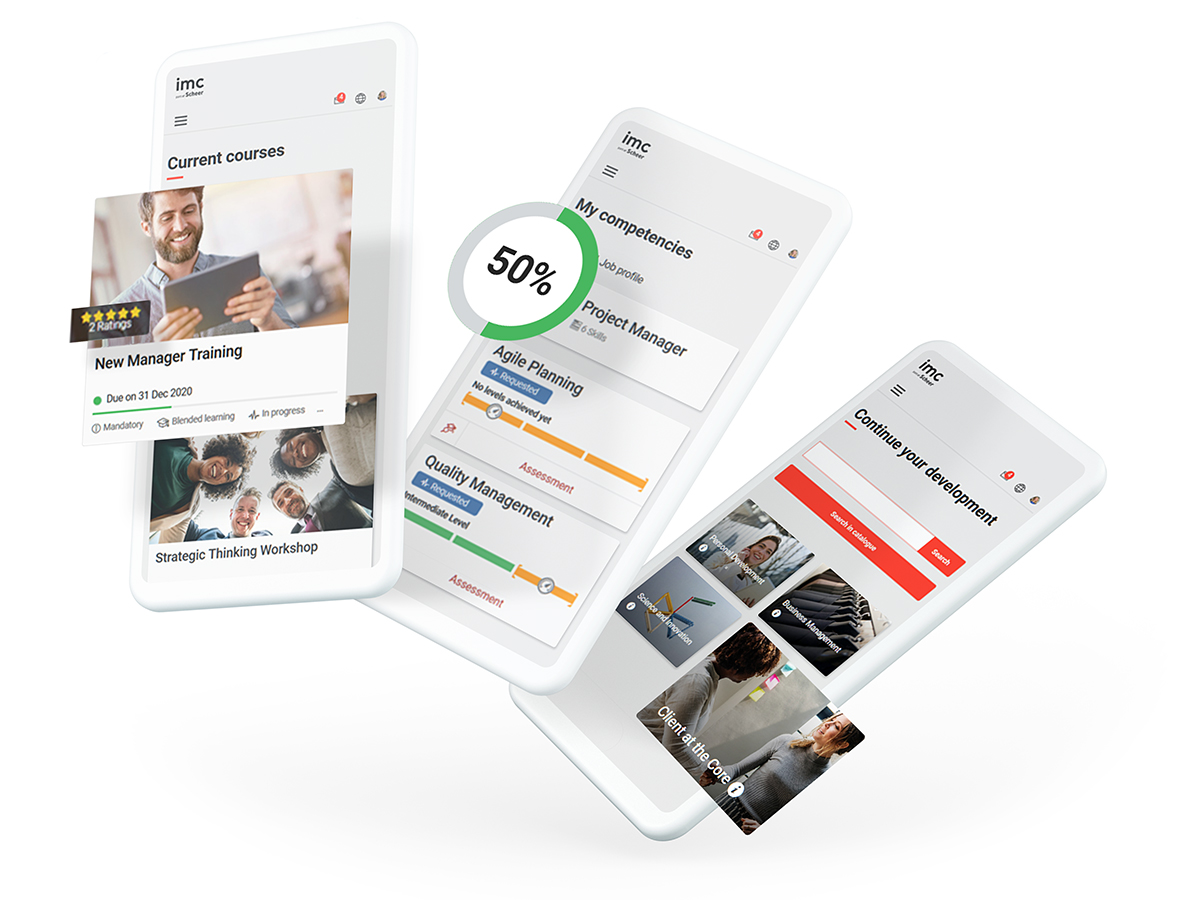
More about our LMS
If you would like to learn more about imc's Learning Management, check here for more information.

Contact person
I have been working in the Marketing & Communication Team at imc since March 2019.
Communication, creative content and social media are my passion. "KISS - Keep it short and simple" is my credo.
To explain complex content in an understandable way and thus make the topic of e-Learning accessible to everyone is an exciting challenge every day.
Privately I love to read, play poker and travel a lot.
I am always happy to receive feedback or suggestions.

The Role of Compliance in Digital Learning Transformation
Here we look at the important role of Compliance within digital learning transformation projects. Whether you have an Audit / Compliance or L&D role, digital transformation is likely impacting your plans, especially if you work for a large, forward-thinking organisation.
According to Gartner, global IT spend will hit $4.4 Trillion in 2022. Despite geopolitical uncertainty and residual pressures from the pandemic, business and IT leaders are actually looking to invest more in digital technology, in order to ensure greater flexibility and future-proofing of their organisations.
In fact, “Investment in direct digital transformation projects is projected to grow at a compounded annual rate of 16.5 per cent from 2022 to 2024” according to the International Data Corporation.
When it comes to digital transformation programmes, leadership teams are often sold on the ideas of faster processes, cost-savings and slicker sales enablement. For L&D, the Covid-19 pandemic accelerated the trend towards digital learning, as the face to face classroom environment became impractical.
What tends to get neglected within digital transformation is the area of Compliance. Legal and regulatory compliance is often seen as a tick-box exercise - “make sure passwords are secure for that new software”, “make sure the new guy gets his health and safety walkthrough before he starts” etc.
However, digital transformation can deliver as much in the way of improvements and efficiencies for Compliance teams as for any other department, while embedding compliance considerations can streamline every department’s processes by automating many recurring tasks related to training.
If you are involved in a digital learning transformation project, here we look at some of the key compliance considerations and potential benefits.

Automated alerts to new laws and regulations
A key role of Compliance teams is to keep track of the latest applicable laws and industry regulations, then liaising with L&D and / or relevant departments in order to roll out training accordingly.
When a robust, well-integrated learning platform is in place and you have an easy to use elearning authoring tool, the Compliance department may be able to update or add relevant information to the platform themselves so that push notifications will get sent to the appropriate employees automatically and if necessary, instantly.
Alternatively, Learning and Development teams can integrate the new information into the next round of training made accessible in the right place, at the right time.
Hassle-free audits
You may be quick and diligent when it comes to delivery of compliance training, but when it comes to an audit from external bodies, this needs to be proven.
Digital learning transformation reduces or completely removes the need for certification paperwork, so that demonstrating the appropriate level of training and accreditation becomes much quicker and easier. Gone are the days of lost certificates - hiding in the wrong file.
A good learning management system (LMS), such as the imc Learning Suite, makes all training and certification information easily navigable and searchable.
Personalised learning and refresher training
Often, compliance training is required when an employee joins a company or starts a new role. This means that revised or refresher training is required on a very individualised schedule.
Digital learning solutions enable these requirements to be managed for each employee as they progress through an organisation or take on new sideways responsibilities.

Powerful data
Compliance teams are often under pressure to do their jobs while staying out of the way as much as possible in order to allow employees to get on with their day to day responsibilities, such as customer service, operational work or revenue generation.
A digital learning platform gives L&D and compliance teams access to useful data so that trends can be seen in where an individual might need additional support for certain aspects of training or where a certain course is causing strange delays or roadblocks.
Such data can enable personalised learner interventions rather than bombarding a whole department with additional training that only a few people need to stay compliant. It also allows Compliance or L&D teams to improve training content that causes bottlenecks for a whole cohort of learners.
Risk mitigation
The whole point of the Compliance function is to allow an organisation to run fluently while staying on the right side of the law or industry regulator.
Through access to data generated by digital learning systems, a Compliance manager is empowered to better manage risk across the company. An effective digital transformation programme integrates every department and a great deal of their training.
Without acting like a ‘Big Brother’ presence in the company, the Compliance team can look into the development of processes and related training, offering guidance and risk mitigation processes along the way.
In Summary
The five principles above offer a guide to how Compliance teams and their collaboration with L&D can make digital learning transformation a fundamental part of a progressive, digitally-savvy organisation.
For those companies on a broad digital transformation programme, Learning and Compliance can help every department to run ever more smoothly and efficiently while managing the risks that come with any change much more effectively.

Don't call it compliance
Most of the time, employees are reluctant to complete mandatory compliance training since it's always unengaged and dull. We give some tips of creating an interesting training instead.

Efficiently implement compliance topics
Discover how to improve employees motivation and learning experience by using a modern learning management system platform.

Diary of a Learning Management System
imc Learning Suite: Six pro tips to make your life easier when working with the LMS
Ever had words with your car? Yelled at the TV? Sworn out loud as you stab angrily at your PC keyboard? Or muttered “stupid system!” – only to discover, somewhat sheepishly, that the problem lay with you, not the system? It’s OK, we’re no different. Our consultants are intimately familiar with this phenomenon, too.
That’s why we talked to our consultants about the misconceptions and obstacles that most frequently cause LMS clients grief, and how they can be overcome. And sometimes it’s good to see things through the other person’s eyes, so we’ve decided to write this from the point of view of our learning management system and share some tips for a better handling of the LMS. That’s right, you may not be aware of it, but our LMS has feelings too, and it’s only trying to help!
The following excerpt from the diary of our learning plattforn is a light-hearted take on human-system interaction, but it contains genuine and practicable expert advice that will hopefully make working life less stressful and more relaxed for all concerned – you, the system, and our consultants.

Dear Diary,
8 a.m.: Dealing with a sudden mass influx of visitors
This morning, I wasn’t even fully awake and was hoping for a slow start to my day, but then I received another error message from China. It was from that important guest who checked in recently. Humans, by the way, always call guests “clients”, but “guests” sounds so much nicer to me.
Anyway, this super-important guest thinks it’s okay to check in an additional 50,000 learners without first telling us and giving my human colleagues – imc’s consultants and architecture experts – a chance to make the necessary server preparations. These preparations are quick to implement, but they’re not instantaneous. I mean, have you ever tried to find room for 50,000 guests who show up on your doorstep unannounced? We pride ourselves on being great hosts, and part of being a great host is being prepared.
Pro tip 1:
If you know you are going to need a large volume of additional licences, please give the consultants in charge seven to ten days’ advance notice.
Note: This does not apply to completely new clients or enterprise groups. In these cases, the preparations take an average of three months, as the process is a lot more involved.
12:15 p.m.: Bugs vs. user errors: Banishing misconceptions
My personal coach, Lia, always says I need to work on my stress management – it was her recommendation to keep a diary. I like Lia. She listens and helps me manage my endearing little peculiarities – the things that humans for some reason call bugs.
Bugs! Such an unkind word to use, given that everyone has their little quirks and tics. And to be perfectly honest, many of so-called bugs are not actually my fault, they’re user errors. There is always potential for user error, which is why my human colleagues and experts – wonderful people like Andreas and Christian – are there to help. They are excellent human-machine interpreters and are only too happy to clear up these sorts of little misunderstandings and misconceptions.
Pro tip2, for system administrators
Please do the user training sessions with our consultants and refer to the relevant training documentation. It will save a lot of time, boost productivity and reduce stress. That’s a promise!
1:00 p.m.: How gamification boosts motivation and enhances learning outcomes
It’s so pleasing to see that my new functions are being accepted and used by more and more guests. And to think that only a couple of years ago, they still had to log in separately to every system I’m connected to. Such a chore and a bore! But now, thanks to single sign-on authentication, it’s all so much simpler, and they can now access the entire learning ecosystem with a single click.
A lot has happened on the gamification front too. Being able to collect badges after completing courses is extremely motivating and makes learning much more fun. Up until quite recently, gamification tended to be frowned upon, especially in the more staid German companies. They’re supposed to be learning, not playing! Well, I disagree, because I can combine learning and play.
Successful learning comes from motivation, which is why I wholeheartedly recommend my skill management feature. With skill management, I can facilitate employee development by highlighting the skills employees already possess, and those they are yet to acquire.
The employer can then compare this information with the skill requirements in job profiles to identify which candidates still need development in specific areas, and which ones are suitable for the role because they already have the required skill set. This can be applied to all selection scenarios, from promotions to filling vacancies. I firmly believe that not using this feature is a wasted opportunity, particularly for guests who have a lot of office-based employees.
Pro tip 3
Don’t be afraid to move with the times! E-learning is so yesterday. Today, it’s all about creating unique learning experiences. Whether it’s small hacks, the use of gamification, or skill management, your employees will not only love it, they will become more productive.

3:30 p.m.: Using Netflix-like features to create unique learning experiences
Time for a coffee break, time to share a little secret: I will soon be getting some amazing new functions. And the best thing about it is that people are comparing me with Netflix – finally, a function that’s instantly recognizable for every user! Very clever of my developers to have come up with this: my new ability to recognize when different items of learning content deal with related topics. I can now recommend new courses or learning videos based on these similarities.
I can’t wait to see how this function is received once the first guests start trying it out. Who ever said learning systems are unsexy?
Pro tip 4
You should definitely check out the new channel function. Channels not only look great, they transform learning into a real experience.
3:45 p.m.: Courses and learning paths made easy
That’s my caffeine fix sorted. Time to move on to the next real challenge – in the form of a new guest from Australia. This guest creates three new courses, then complains that there’s no easy overview of who has done the courses or completed the tests.
But that’s another major misconception, unfortunately, because the solution he needs is already there: learning paths. Let me explain. First of all, there’s learning content. That can be any kind of training, whether face-to-face or digital. If I combine multiple items of content, then that’s a course. I can then combine multiple courses to create a learning path. If I want to, I can then also define various course prerequisites.
The idea of prerequisites is that the learner can’t progress to a higher-level course until they have passed the courses below it. You can even create placeholders – course templates – for individual courses in the learning path if, say, the course dates have not yet been finalized. Guests can then book the relevant courses in the learning path once the dates have been finalized, and the courses created. With this set-up, the administrator will always have total transparency regarding how far along the learning path the individual learners are, and can see full details of the courses.
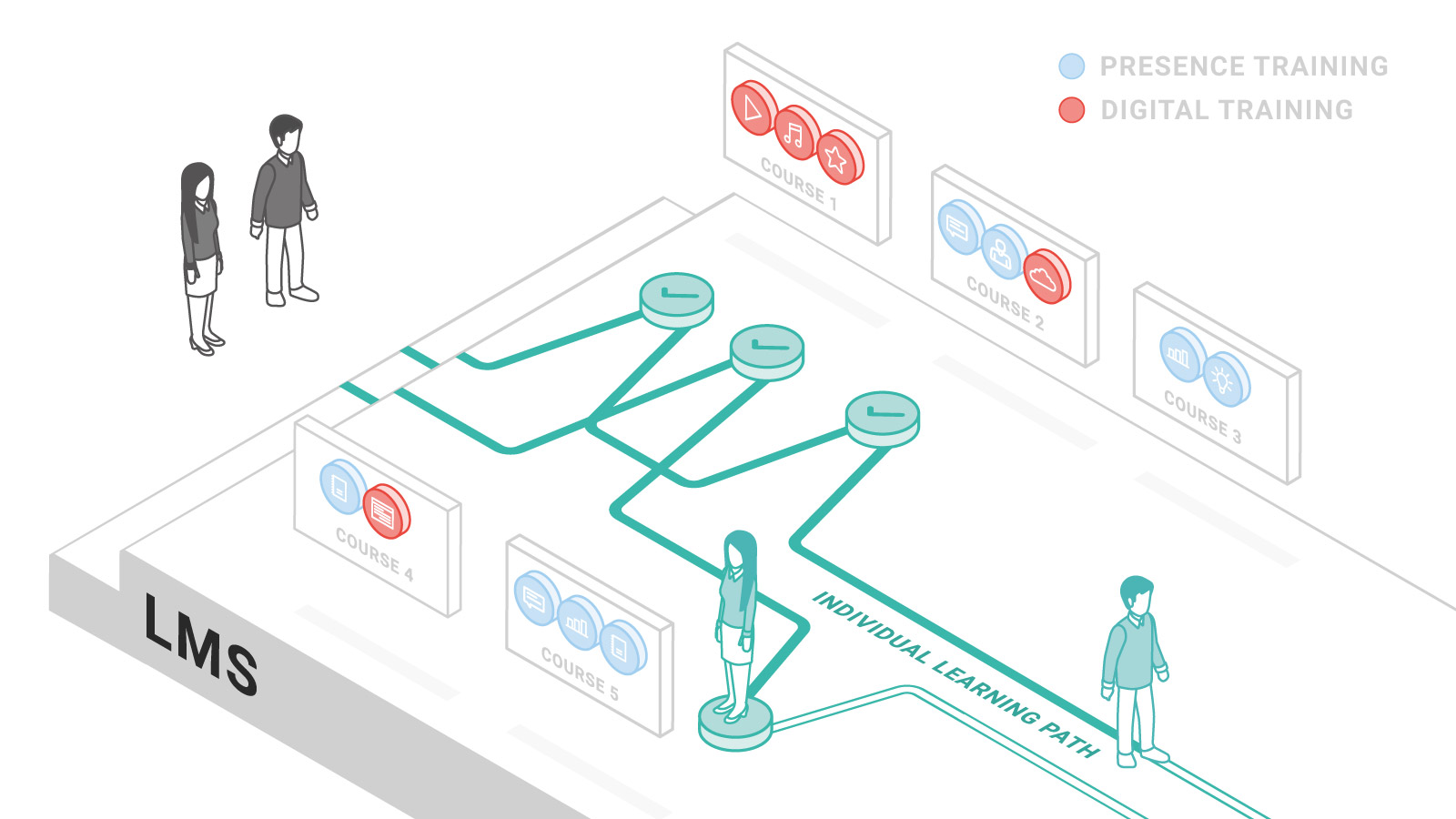
Pro tip 5
Learning paths need to be well thought out because they are intended for longer-term development programmes. In that sense, they are like semester schedules at universities. The latter comprise various lectures or courses, and by the end of the semester, students need to have attended all the lectures in order to pass.
So, it’s important to think carefully in advance about the purpose for which an item of learning content, a course or learning path is being created. Once you have created a learning path, it’s not that easy to make changes. If you are unsure, it’s best to double check with our consultants.
5:00 p.m.: Smart decisions with learning analytics
What a day! But the end is in sight. Meanwhile, there’s something I really want to get off my chest: I’m a precision system, and I can show humans exactly what they want to – or are allowed to – see, but only if they correctly specify what they want via my user interface.
The same principle also applies to authorisations. It makes total sense that sales consultants who only sell, say, drilling machines should not need access to user guides for gardening tools. But to give effect to that, you actually need to specify it in the roles and rights concept. That way, the group defined as “sales consultants for drilling machines” will only be able to view user manuals for drilling machines.
Also, my creators are constantly talking about learning analytics and how it can be used to create really cool dashboards. That’s another new functionality that I’m very proud of. Learning analytics enables you to “measure the business outcome of the learning process,” as my big boss and Head of Product Management here at imc, Wolfram Jost, would say. In other words, learning analytics lets humans track whether they are getting a good return on their investment in learning. Definitely a key technology to keep an eye on!
Pro tip 6
To get the right answers, you have to ask the right questions, so, if you would like to make purposeful use of learning analytics, it’s worth talking to a data expert or asking our consultants about targeted training courses.
6:00 p.m.: Performance review and new developments on the horizon
Well, it’s nearly time to finish up for the day, and I’ve got a really nice evening planned. The product management team will be coming by shortly, and I’ll be paying really close attention to what they say, because it’s about my future. I love my product managers because they’re always checking me over closely to spot untapped potential and find ways of making me even better than my competitors. Time to grab some data snacks, sit back and relax. I can’t wait to find out what updates they’ve got in mind for me.
Ok, Diary, talk to you again tomorrow!

Learning Ecosytem: A universe of Learning
If you want to use a learning ecosystem successfully in corporate learning, the technical requirements must be right. Time to shed light on what systems have to fulfil in order to be able to meaningfully map a genuine learning ecosystem.
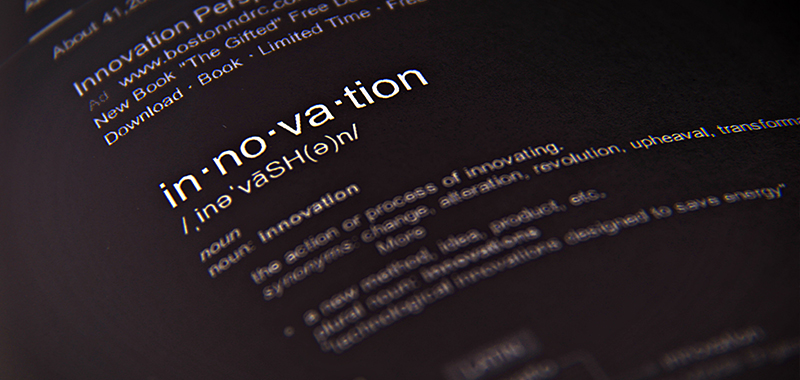
The Ultimate eLearning Jargon Glossary
LMS, LXP, SCORM, WBT, EPSS, NGLE, CBT, ITS!? Lost in a world of elearning terms and abbreviations? No worries, we can help. In this A to Z, we shed some light on the subject and have compiled a list of the most important terms and abbreviations in the field of e-learning in 2022.

More about our LMS
If you would like to learn more about imc's Learning Management, check here for more information.

Contact person
I have been working in the Marketing & Communication Team at imc since March 2019.
Communication, creative content and social media are my passion. "KISS - Keep it short and simple" is my credo.
To explain complex content in an understandable way and thus make the topic of e-Learning accessible to everyone is an exciting challenge every day.
Privately I love to read, play poker and travel a lot.
I am always happy to receive feedback or suggestions.

